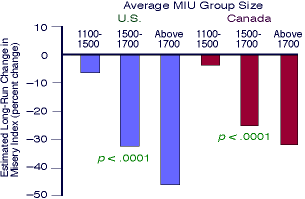Effect on Economic Growth
Economic growth depends on the “investor climate,” “consumer confidence,” and other aspects of the collective consciousness of any society. If the mood of society turns anxious and fearful, investor’s won’t invest, banks won’t lend, managers won’t spend, and consumers won’t buy. This is why, at the bottom of the Great Depression, President Franklin D. Roosevelt said, “All we have to fear is fear itself.” If, on the other hand, society’s mood becomes confident and optimistic, people at every level of society will make the positive decisions that drive economic growth. To a significant degree, the performance of the economy depends on the quality of collective consciousness.
The following is one of 16 demonstrations showing that peace-creating groups, by reducing stress in the collective consciousness, improve economic performance.
|
Decreased Inflation and Unemployment—
Improvement in the “Misery Index” |
|
 |
|
The “Misery Index” is a particularly meaningful measure of economic dysfunction, combining unemployment and inflation. When the two components go up simultaneously, the economy is badly misfiring: High unemployment means economy stagnation, and high inflation (usually associated with good economic times) means that prices are going up as income is going down—a recipe for consumer misery.
This study compared the monthly Misery Index with monthly changes in average attendance at the peace-creating assembly at Maharishi University of Management from April 1979 to January 1987 (the university was then known as Maharishi International University, or MIU). When more than 1,500 people participated daily in the peace-creating group, during the following months (and in both the U.S. and Canada) the Misery Index significantly decreased. When the group size was smaller, averaging 1,100–1,500, both countries displayed smaller declines.
Time series analysis showed that the peace-creating group had a highly significant impact on both the U.S. and Canadian Misery Index. These results indicate that peace-creating assemblies improve the performance of key economic variables, even across national boundaries. It is worth noting that strong economic growth also contributes to peace—by reducing the economic misery that leads to social unrest.
Reference: Proceedings of the American Statistical Association, Business and Economics Statistics Section, 1987 (pp. 799-804). Alexandria, VA: American Statistical Association.
|
To move to the next Summary,
click here:

To continue with more detail on this topic,
click here:

|
|


